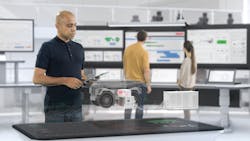Operator competence accelerated, augmented
“My father retired a few years ago, having worked in a similar production environment for many years,” Matias explains. “He never even got to sit at the plant’s control console until he had years of tutelage under the supervision of older operators who trained him first out in the field what to listen for, what to watch out for, and what steps to take if something went wrong. It was all word of mouth, but even then, maintaining production was a difficult task, as they didn’t have access to the kind of real-time data and predictive diagnostics I do today. Plus, those senior employees are all now retired as well, and their experience left with them. I hear the company’s really struggling to maintain production, given the shortage of new recruits who don’t have the experience necessary to run the plant, and those who do have an aptitude to learn to do so have gone elsewhere to seek a more modern work environment.”
Also read: Where will your DCS take you?
“I’ve been much more fortunate,” Matias continues. “The mining operation at which I work invested in process automation system technology from ABB back in the 2010s, and over the years we’ve been able to continuously evolve our systems to take advantage of new technologies—especially the latest tools for knowledge capture, operator assistance and training.”
A new normal
Not surprisingly Matias and his other digital native coworkers expect data to be available where and when they need it on their tablets, phones and watches—as well as on hands-free, augmented reality displays, where they can also tap into process diagnostics and guided operational assistance for troubleshooting and resolving process issues. “At the operator console, we also have guided access to information on handling issues that arise—a big improvement to the low visibility into causes and effects that used to complicate any changes to control parameters or interlocks.”
“Today, our distributed control system environment from ABB also includes embedded digital twin technology, which powers the training simulator that we use to bring new operators and technicians up to speed on our processes,” Matias adds. “I understand these capabilities used to be too expensive or inflexible to justify if your operations weren’t in a very profitable or stable, mature industry. But now those capabilities are built into the platform, and we take advantage of them every day.”
Another advantage of operations in 2032 is the redistribution of plant operations to include an efficient blend of on-site operations, remote operations and even the use of self-driving trucks and robots to handle explosives and provide a safe environment for operators and engineers. For Matias, this also means that a centralized operations group in Santiago is on call to help fill in gaps in local coverage as well as remotely help troubleshoot operational issues. “If need be, I can also securely access operations from home without jumping through unnecessarily cumbersome set-up issues. It’s secure by default,” he says.
“All in all, we have ready use of historical data, trend recognition, inferential modeling and other data-mining technologies that our predecessors could only dream of,” Matias says. “Our systems can predict process behavior based on current parameters. And, it can recommend new parameters that help optimize that performance.”
Note: The characters and organizations depicted in this vision are fictitious. The ABB DCS Vision, however, is very real. Download the white paper at https://new.abb.com/control-systems/control-systems/envisioning-the-future-of-process-automation-systems.
This was just one stop on our tour of ABB's Process Automation Systems Vision 10 years in the future. Don't miss a single stop. Read more at the articles below.
About the Author
ABB
ABB

Leaders relevant to this article:

